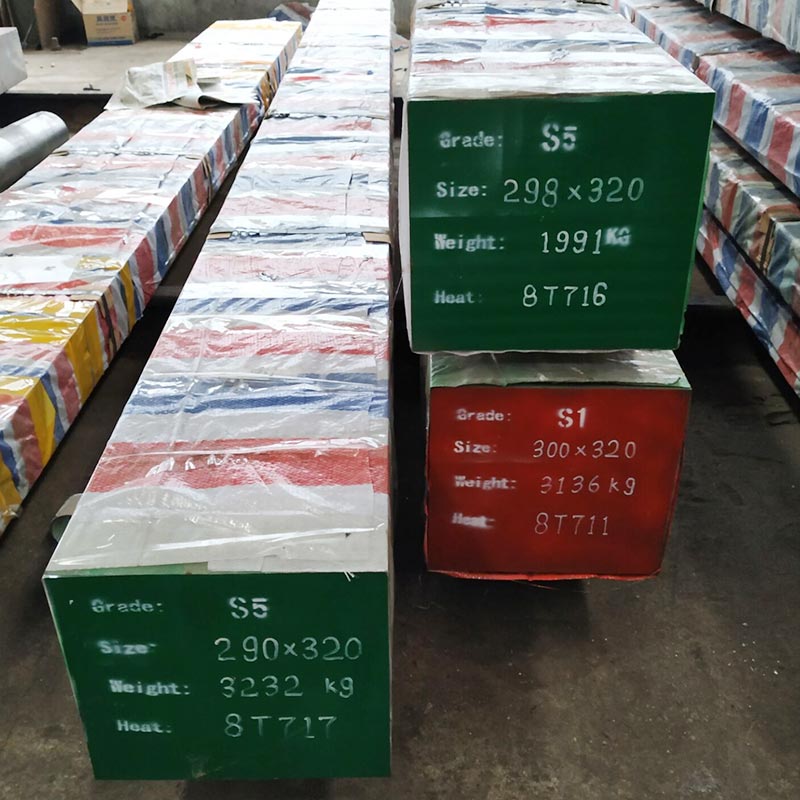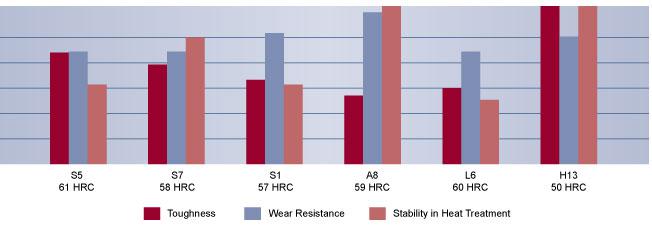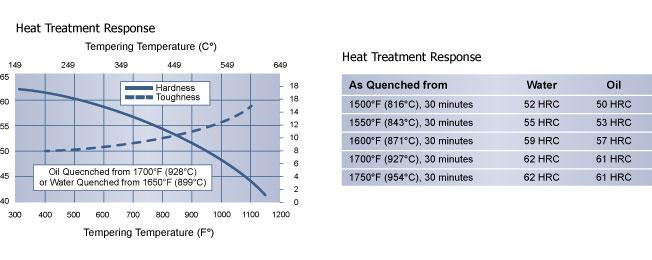Tel.: +86 714 3703 589 E-mail: [email protected]

Preheating: Heat at a rate not exceeding 400°F per hour (222°C per hour). For complex and large tools, heat to 1150-1250°F (621-677°C) and equalize. Then heat to 1300-1400°F (704-760°C) and equalize. For simple geometries, use only the second preheating temperature range.
Product Details
S5 Shock-Resisting Tool Steel is a silicon-manganese tool steel which exhibits the highest impact toughness among all of the "S" type steels. The high toughness and the ability to be hardened to 62 Rockwell C make S5 an excellent choice for applications that require higher strength than S7 shock-resisting tool steel. The steel is typically hardened using an oil quench, but for simple geometries, the steel may be water quenched.
APPLICATIONS: Pneumatic tools, shear blades, mandrels, heavy-duty punches, and stamping dies.
COMPOSITION
| C | Mn | Si | Cr | Mo | V |
| 0.60 | 0.90 | 1.90 | 0.18 | 0.35 | 0.28 |


PHYSICAL PROPERTIES
Density: 0.280 lb/in3 (7750 kg/m3)
Specific Gravity: 7.75
Modulus of Elasticity: 30 x 106 psi (207GPa)
Machinability: 65-70% of a 1% carbon steel
HEAT TREATING INSTRUCTIONS

HARDENING
Critical Temperature:
Ac1: 1410°F (766°C)
Preheating: Heat at a rate not exceeding 400°F per hour (222°C per hour). For complex and large tools, heat to 1150-1250°F (621-677°C) and equalize. Then heat to 1300-1400°F (704-760°C) and equalize. For simple geometries, use only the second preheating temperature range.
Austenitizing (High Heat): Heat slowly from the preheat. For Oil Quenching: 1600 - 1700°F (871 - 927°C) For Water Quenching: 1550 - 1650°F (842 - 899°C) Soak for 30 minutes for the first inch (25.4 mm) of thickness, plus 15 minutes for each additional inch (25.4 mm) of thickness.
Quenching: Oil or water to 150-125°F (66-51°C).
Tempering: Temper immediately after quenching. Hold at temperature for 1 hour per inch (25.4 mm) of thickness, 2 hours minimum, then air cool to ambient temperature. To minimize internal stresses in cross sections greater than 6 inches (152.4 mm) and to improve stability in tools that will be EDM’d after heat treatment, a soaking time of 4 to 6 hours at the tempering temperature is strongly recommended.
Cryogenic Treatment: Some prefer to do cryogenic treatment as an extension of the quench from the austenitizing treatment. Others prefer to cryogenically treat after tempering.
ANNEALING
Annealing must be performed after hot working and before re-hardening.
Heat at a rate not exceeding 400°F per hour (222°C per hour) to 1425 - 1475°F (773 - 801°C), and hold at temperature for 1 hour per inch (25.4mm) of maximum thickness; 2 hours minimum. Then cool slowly with the furnace at a rate not exceeding 50°F per hour (28°C per hour) to 1000°F (538°C). Continue cooling to ambient temperature in the furnace or in air. The resultant hardness should be a maximum of 229 HBW.